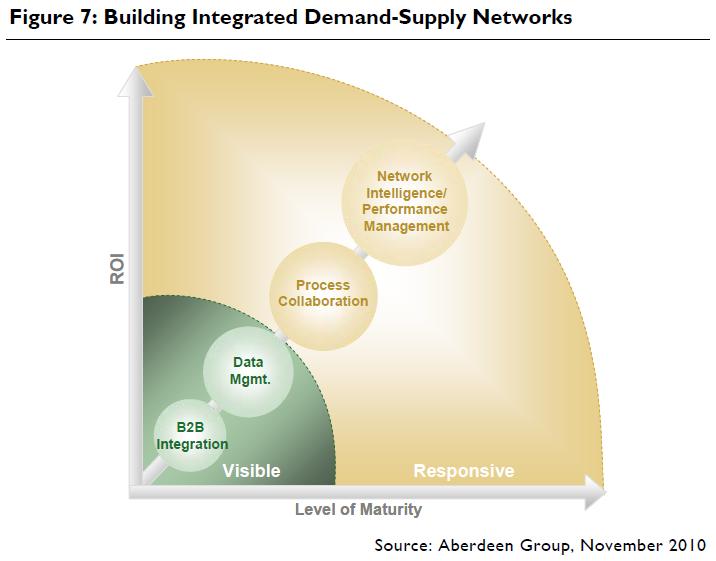In January I wrote a blog titled “Social networks and supply chains: It’s a question of maturity” in which I commented on the incorporation of social media concepts in supply chain management in which I referred to a research report by Nari Viswanathan at Aberdeen. In a follow-up to the report, dealing largely with the early stage of maturity, titled “Enabling Supply Chain Visibility and Collaboration in the Cloud" Nari writes that;
Best-in-class companies have gained significant improvements … when it comes to collaborative processes…This ensures that they will continue moving toward integrated demand-supply networks. This trend is bolstered by the rising importance of this process [collaboration] for succeeding in the multi-enterprise supply chain.
But the early stage of maturity, B2B integration, is a very necessary step toward collaboration. Without the data there can be no visibility or collaboration. However, pure visibility is over-whelming because of the volume of data. There must be a filter mechanism that not only identifies the important information, but also who should know about this information. It is important to recognize that the importance of the information is going to change according to a person’s role and responsibility. Not only that, but often the consequence of an event is more important than the event itself. Let me give an example. Say a supplier cannot meet a delivery date and instead will deliver the order 1 week later than previously agreed. Who should know? Clearly the purchasing agent responsible. Do we know who that is and can we alert them? Or does the purchasing agent need to find this information themselves? (Often they do.) Does anyone else need to know? What about the manufacturing manager whose line is about to run out of materials? If the line is stopped for only for an hour does the manufacturing manager want to know? Possibly, but if it is for a day then definitely. But does the manufacturing manager need to know the details about the late supply? Probably not. Similarly a customer service rep may only want or need to know if an order for an important customer will be delayed by more than two days, but they are unlikely to be interested in either the line stoppage or the late delivery. What about the VP of Sales? Does he/she need to know about the late order? Probably not, unless it represents a significant portion of the sales for the quarter. Even then the Sales VP will be a lot more interested in this information at the end of the quarter rather than at the beginning of the quarter. Of course in this discussion I am assuming that security exists that identifies who is allowed to know. In other words a notion of responsibility is necessary to take the raw data provided by visibility and convert it into actionable information. The questions that need to be asked are:
- Who should know?
- Why should they know?
- What should they know?
This is very different from current concepts of social media and social networks in which every piece of information is treated as having equal importance and all the information is sent to everyone who is ‘following’ the publisher. Even within the world of Facebook and Twitter the issue of volume of information and relative importance of information is receiving some attention. But in a multi-tier, outsourced, off-shore supply chain the notion of responsibility is absolutely crucial to separating the important from the trivial and to sending the information to the right people, namely those who are affected and those who can affect the consequences. In a blog titled “Social media to improve supply chain?” Matt Davis of Gartner, in discussing examples of the use of social media in supply chain management, concludes that;
But so far, these examples are all, shall we say, supply chain adjacent. Supply chain leaders will use demand insights to orchestrate their environment. Both into the sales channel as well as back to their suppliers. Examples of this capability are still few and far between in traditional supply chain, let alone through social media. Will companies ever use a social media platform to manage factory capacity or expedite raw material shipments? That remains to be seen. But I am seeing where social media helps bridge the functional divide between the demand drivers (sales and marketing) and supply chain responders. As demand requirements from customers are better understood, the first question asked is often, “how are we going to do this?” And that connects the demand sensing to the supply chain execution.
So Matt touches on the notion of consequence – that connects the demand sensing to the supply chain execution – but does not address the notion of responsibility. As importantly though, Matt identifies where social media can break down the barriers between functions and organizations to facilitate collaboration and more agile and responsive supply chains. The notion of responsibility is necessary to make the use of social media in supply chains effective rather than overwhelming. The value of social media in the supply chain really kicks in once the group that is required to collaborate to reach consensus/compromise has been identified. The secret sauce is in identifying who belongs in the group.





Discussions
Leave a Reply